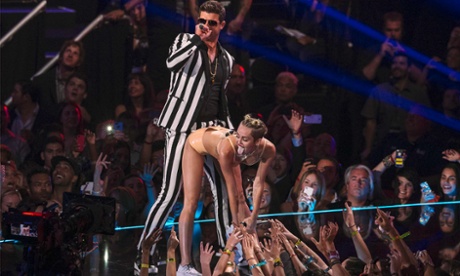
David Cameron announced on Monday that online music videos will carry age ratings as part of a pilot scheme bringing them into line with films.
The videos will go through the same classification system as films and other video content, in an attempt to give parents more information to protect children from “graphic content”.
The voluntary pilot will involve the big three music labels in the UK – Sony, Universal and Warner Music – as well as the British Board of Classification (BBFC), YouTube and music video platform Vevo.
How long will the pilot last?
It will run for three months, kicking off in October. Music videos sold or distributed on disc or other physical form and deemed to include 12-rated-plus material will also have to go through the same age-classification process starting in October under amendments to the Video Recording Act.
Who will do the rating?
The music labels will submit music videos that they consider could contain content that should be classified as for age 12 or over, using BBFC guidelines. The BBFC will then rate the videos as it does with other content, for which the labels will pay a fee to cover the cost of rating in the same way that the film industry currently does. The rating process should take around 24 hours, according to the BBFC.
A rating of 12, 15 or 18 will be assigned to the music video and passed on to the label. Videos deemed not to include objectionable content for children under 12 will not be classified.
Will it just be music videos?
The pilot scheme announced by Cameron will only cover music videos and will not be expanded to cover other video content on sites such as YouTube.
What form will the rating take?
The music labels will tag the video with the age rating from the BBFC when uploading the video to hosting services. YouTube and Vevo are part of the pilot study, and will be supporting the ratings, placing a visible age rating on the video title on the respective sites.
The visible rating will probably take the form of the BBFC’s age certification logos, although that is not yet set in stone, and is intended to give parents more information about the videos their children are watching.
YouTube has a similar system for displaying BBFC ratings on films, and requires users to be at least 13 years old to have an account, although most videos are viewable without an account.
Will it just be a notification, or will there be filters or proof-of-age required?
The three-month pilot is intended to finalise a system that works for rating the videos and having the data tagged to them when uploaded to say they are classified. For the initial trial it will simply be a notification on the video of an age classification.
After the three-month trial it is expected that YouTube and Vevo, as well as other video hosting services, will look at developing parental control filters that screen out videos marked as inappropriate for children of specific age ranges.
Filters at an internet service provider level, like those used to screen pornography entirely from a home broadband connection, could also be applied at a later date.
Which music videos will be rated?
Only new videos submitted by the music labels will be rated during the pilot, although there will be a decision at the end of the pilot as to whether videos that are already available should be retroactively classified.
What about other labels?
The big three labels will conduct the pilot, but the BPI, which represents Sony, Universal and Warner Music and more than 300 independent music companies, expects that all music labels will adopt the system once finalised.
How will this help protect children?
During the pilot the ratings will be there for information purposes only, to help parents make an informed decision. Parental controls on YouTube and others could be used to screen out videos via ratings, but their effectiveness will be determined by how difficult it is to get around age verification.
YouTube, like most other online services, does not verify a user’s age beyond the date of birth given by the user at the point of signing up for an account. Users could also simply log out to view a video, or watch it on another device, unless requirements are made to force some sort of strong age verification, which is beyond the scope of this initial pilot scheme.
• YouTube’s young celebrities shine at biggest ever UK convention

